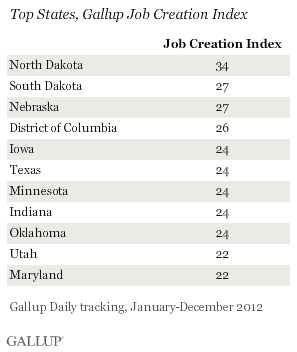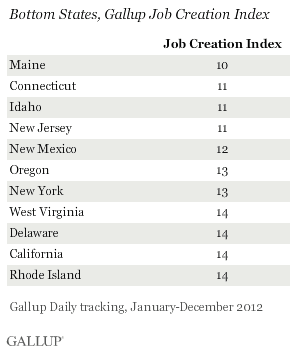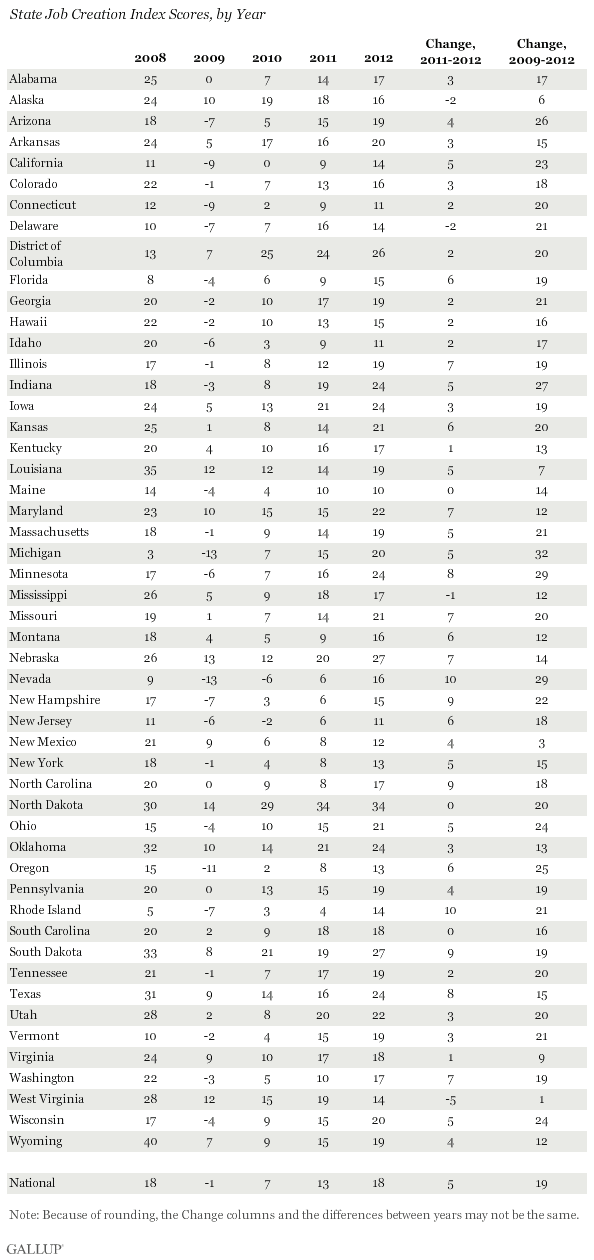PRINCETON, NJ -- North Dakota led the nation in job creation in 2012, according to worker self-reports of hiring activity at their places of employment. Five more states in the Midwest -- South Dakota, Nebraska, Iowa, Minnesota, and Indiana -- rank among the top states. Maine had the lowest job creation score, along with Connecticut, Idaho, and New Jersey.


On average in Gallup Daily tracking from January through December 2012, 43% of North Dakota workers said their company was hiring workers and expanding the size of its workforce, while 9% said their employer was letting workers go and reducing the size of its workforce, for a +34 Job Creation Index score. This is easily the best among the 50 states and the District of Columbia, and is 16 percentage points above the national average of +18. North Dakota has ranked first four years in a row. Full results by state for 2012 can be found on page 2.
South Dakota, Nebraska, Iowa, Indiana, Oklahoma, Utah, and the District of Columbia have also all ranked among the top states in hiring in 2011 and 2012.
Maine is new to the bottom 10 states in 2012, compared with 2011, largely because its +10 Job Creation Index score was unchanged while most states showed improvement. Connecticut, Idaho, New Jersey, Oregon, New Mexico, New York, and California are the seven states that made a repeat appearance among the bottom 10 in 2012.
More generally, Eastern states lagged behind others in job creation in 2012, while the Midwest clearly enjoys the strongest hiring situation of the four regions.
These regional patterns in job creation have been evident for several years.
Most States Showed Better Hiring Situation in 2012
The nation's Job Creation Index improved to +18 in 2012 from +13 in 2011. As a result, most states showed some improvement last year. Nevada and Rhode Island showed the greatest improvement, with 10-point increases. Both states had previously ranked among the worst states for job creation but no longer do.
In contrast, West Virginia -- one of few states that did not show improvement last year -- fell back into the bottom group of states after ranking near the top in prior years.

The national Job Creation Index score of 18 is now back where it was in 2008, prior to the worsening of the U.S. job market after the financial crisis late that year. In 2009, the national Job Creation Index fell to a low of -1, indicating that more employees reported their employers were reducing workforce size than increasing it.
Since 2009, Michigan (up 32 points), Nevada, and Minnesota (up 29 points each) have shown the most improvement in job creation, and West Virginia the least (1 point).
Implications
North Dakota continues to show the most positive hiring situation, according to people who work in that state. The state's job market is bolstered by energy production, but also technology and agriculture. The jobs boom there is creating a ripple effect by generating a need for other services, such as construction. Hiring is also strong in North Dakota's neighboring states, such as South Dakota and Minnesota. Meanwhile, hiring continues to lag in Eastern states, perhaps due to the continued struggles of financial services firms.
Still, nearly every state showed improvement in job creation last year, and every state with the exception of West Virginia has at least a somewhat better hiring situation than in 2009, when employees reported the bleakest job market in recent memory.
Gallup's "State of the States" series reveals state-by-state differences on political, economic, and well-being measures Gallup tracks each day. New stories based on full-year 2012 data will be released throughout the month of February.
Gallup.com reports results from these indexes in daily, weekly, and monthly averages and in Gallup.com stories. Complete trend data are always available to view and export in the following charts:
Daily: Employment, Economic Confidence, Job Creation, Consumer Spending
Weekly: Employment, Economic Confidence, Job Creation, Consumer Spending
Read more about Gallup's economic measures.
View our economic release schedule.
Survey Methods
Results are based on telephone interviews conducted as part of Gallup Daily tracking Jan. 1-Dec. 31, 2012, with a random sample of 200,225 adults, aged 18 and older, employed full or part time, living in all 50 U.S. states and the District of Columbia.
For results based on the total sample of employed adults, one can say with 95% confidence that the margin of sampling error is ±1 percentage point.
Interviews are conducted with respondents on landline telephones and cellular phones, with interviews conducted in Spanish for respondents who are primarily Spanish-speaking. Each sample of national adults includes a minimum quota of 50% cell phone respondents and 50% landline respondents, with additional minimum quotas by region. Landline telephone numbers are chosen at random among listed telephone numbers. Cell phones numbers are selected using random digit dial methods. Landline respondents are chosen at random within each household on the basis of which member had the most recent birthday.
Samples are weighted to correct for unequal selection probability, nonresponse, and double coverage of landline and cell users in the two sampling frames. They are also weighted to match the national demographics of gender, age, race, Hispanic ethnicity, education, region, population density, and phone status (cellphone only/landline only/both, cellphone mostly, and having an unlisted landline number). Demographic weighting targets are based on the March 2012 Current Population Survey figures for the aged 18 and older U.S. population. Phone status targets are based on the July-December 2011 National Health Interview Survey. Population density targets are based on the 2010 census. All reported margins of sampling error include the computed design effects for weighting.
In addition to sampling error, question wording and practical difficulties in conducting surveys can introduce error or bias into the findings of public opinion polls.
For more details on Gallup's polling methodology, visit www.gallup.com.

